Themen für Bachelorarbeiten, Masterarbeiten und Projekte
Unsere Themen für Bachelor- und Masterarbeiten sowie Projekte stammen aus den Bereichen Softwaretechnik und Programmiersprachen. Die konkreten Themen für Abschlussarbeiten orientieren sich an unseren Forschungsschwerpunkten und ermöglichen es den Studierenden, einen eigenen Beitrag zu einem Forschungsgebiet zu leisten. Zielgruppe sind vor allem die Studierenden der Studiengänge Informatik, Software Engineering, Medieninformatik, Künstliche Intelligenz und Cognitive Systems.
Diese Seite bietet eine Auswahl an Themen und Themenbereichen. Nähere Informationen erhalten Sie bei den jeweiligen Ansprechpartnern. Darüber hinaus sind wir offen für Ihre eigenen Themenvorschläge.
Ablauf einer Bachelor- bzw. Masterarbeit
Themenabstimmung und Proposal
Nach der initialen Kontaktaufnahme werden das Thema und die Inhalte der Bachelor- bzw. Masterarbeit abgestimmt und in einem Proposal festgehalten. Das Proposal hat sich als Tool zur Risikominimierung und Planung der Abschlussarbeit bewährt und beinhaltet:
- der Kontext der Abschlussarbeit
- die Forschungsfrage
- der Stand der Forschung
- die Lösungsidee
- die Methodik und der Evaluationsplan
Ein Großteil des Proposals kann eins zu eins in der Abschlussarbeit wiederverwendet werden.
Zwischenpräsentation
Im Rahmen der Zwischenpräsentation lernen Studierende Ergebnisse zu präsentieren und zu kommunizieren. Darüber hinaus kann im Rahmen der Zwischenpräsentation der bisherige Stand der Abschlussarbeit reflektiert und auf Feedback eingegangen werden.
Abgabe und finale Präsentation
Durch die Abgabe der Abschlussarbeit und die finale Abschlusspräsentation wird die Bachelor- bzw. Masterarbeit formal abgeschlossen.
(Legende - B: Bachelorarbeit, M: Masterarbeit, P: Projekt)
Human-centered Software Engineering
Algorithm Detection
![[RESERVED] B/M: Detecting Non-Trivial Algorithms in Code: How Far Can LLMs Go? (Neumüller, Tichy)](/fileadmin/website_uni_ulm/iui.inst.170/DatasetPipeline.jpeg)
Context
We are convinced that automatically detecting algorithm implementations in a code base can be helpful to gain knowledge about, which concerns are present in the code base, how they are solved and which components are involved. This knowledge can then support the tasks of software comprehension, software architecture recovery and software maintenance.
Examples of algorithms that could be interesting to detect and some of the insights their detection provides:
- Quicksort -> The application sorts data structure x.
- A* -> The application does path search.
- Raft (Consensus Algorithm) -> The application is a distributed, fault-tolerant system.
Research Question
Large Language Models (LLMs) achieve impressive results on code-related tasks such as code clone detection, code summarization and code generation.
Our first experiments using LLMs for algorithm detection indicate promising performance, with F1 scores of about 77%.
However, our evaluation has so far focused only on smaller algorithms such as Binary Search, Bubble Sort, Matrix Transposition etc.
We are now interested in evaluating LLMs on more complex algorithms implemented in real code bases.
Therefore, the main research question of this thesis is:
- How do LLMs perform in recognizing complex algorithms in source code bases?
Tasks
- Create a dataset of more complex algorithms (e.g. Levenshtein distance, Raft), preferably from real open-source projects, using code from GitHub, Maven, or other web resources.
- Adapt the current LLM evaluation code written in Python to support different evaluation strategies, such as file-based and API-based evaluations.
- Evaluate different LLMs (e.g., Deepseek, Mixtral, LLaMA3, ChatGPT) using the dataset and the implemented evaluation strategies.
- Furthermore, we are interested in explaining the predictions of LLMs, (especially for failure cases).
No prior knowledge of machine learning (ML) is required for this thesis. However, you should be open to familiarizing yourself with a new subject area.
Related Work
- Publications regarding the (automated) curation of datasets:
- Publications regarding the application of LLMs to (other) code related tasks:
- Examples of LLM API interaction:
- Publications regarding explanations:
Contact
If you are interested and/or have any questions, feel free to contact me any time.
We can discuss the topic further and try to adapt it to your personal preferences.
Dynamic and Static Program Analysis

Context
Classical code coverage techniques are widely used to give an indication of the quality of a test suite (with respect to its capability in detecting faults within the system under test).
However, they are not always effective and can be outright misleading [1, 2]. Consider a scenario in which you simply execute code within a unit test but never check whether the resulting state is as expected.
While (at least for most languages) this still ensures that the code does not raise a runtime exception, this is way too weak for most use-cases.
As one possible solution, Schuler and Zeller introduced the concept of checked coverage [3], which uses dynamic slicing to only consider the executed code that contributed to something which is checked with an assertion. Later work by Zhang and Mesbah [4] showed that such checked coverage is indeed a strong indicator of the effectiveness of a test suite.
Research Problem
In this work, we want to look at an alternative to dynamic slicing - static slicing, which does not execute the code and hence over-approximates all potential executions. In contrast to a dynamic slice on an assertion, the static slice contains all the code that could potentially affect the assertion, even if it is not executed in a particular test run. This way, we obtain additional information about the test suite and the system under test, yet we do not know whether this information is useful to gauge the effectiveness of the test suite.
Tasks
More specifically the intended steps of this work are as follows:
- Consider a well-supported language such as Java alongside an appropriate 1) static slicer, 2) dynamic slicer, and 3) coverage tool.
- Use these tools to compute the static and dynamic slices for test-suites of real-world Java projects.
- Analyze, compare, and discuss the results of the static and dynamic slices with respect to the code coverage and the effectiveness of the test suite (e.g., using mutation testing).
Related Work and Further Reading
- H. Hemmati, "How Effective Are Code Coverage Criteria?," 2015 IEEE International Conference on Software Quality, Reliability and Security, Vancouver, BC, Canada, 2015, pp. 151-156.
- Laura Inozemtseva and Reid Holmes. 2014. Coverage is not strongly correlated with test suite effectiveness. In Proceedings of the 36th International Conference on Software Engineering (ICSE 2014). Association for Computing Machinery, New York, NY, USA, 435–445.
- Schuler, D. and Zeller, A. (2013), Checked coverage: an indicator for oracle quality. Softw. Test. Verif. Reliab., 23: 531-551.
- Yucheng Zhang and Ali Mesbah. 2015. Assertions are strongly correlated with test suite effectiveness. In Proceedings of the 2015 10th Joint Meeting on Foundations of Software Engineering (ESEC/FSE 2015). Association for Computing Machinery, New York, NY, USA, 214–224.
Contact and More
If you are interested and/or have any questions, feel free to contact me any time.
We can discuss the topic further and try to adapt it to your personal preferences.
Florian Sihler (Institute Homepage)
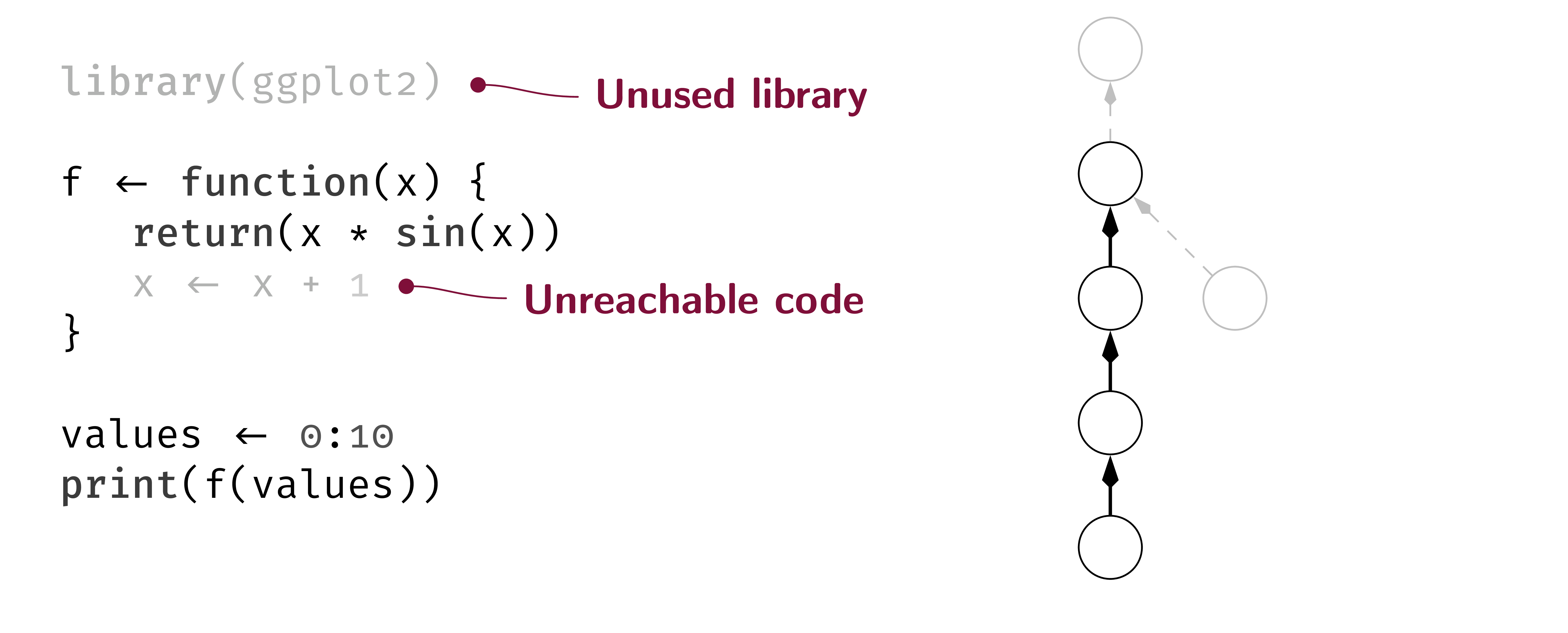
Context
Dead or unused code describes all parts of a program that are either never executed at runtime or never used in any way.
Such parts hinder not only the readability of the program — requiring users first to realize that such snippets do not actually contribute to the program's functionality — but also the maintainability of the code, as users may be afraid that the code could be used in some way [1, 2].
Additionally, dead code can lead to performance issues, as it may cause the definitions of many unused functions, the loading of unnecessary datasets, or the calculation of values that are never used.
Research Problem
Given an R program and information on its control- and dataflow, identify the dead and unused code within the program adapting well known algorithms to the dynamic nature of the R programming language [3,4,5]. For this, we use a static dataflow analyzer called flowR [6] which provides us with a control flow and a dataflow graph.
Tasks
More specifically, the task are:
- Adapt the dead code elimination problem to the R programming language and discuss which code can be removed safely
- Use flowR's control flow and dataflow graph to identify the dead code using your adapted algorithm
- Evaluate and discuss the effectiveness of your algorithm on a set of real-world R programs
Related Work and Further Reading
- S. Romano, C. Vendome, G. Scanniello and D. Poshyvanyk, "A Multi-Study Investigation into Dead Code," in IEEE Transactions on Software Engineering, vol. 46, no. 1, pp. 71-99, 1 Jan. 2020.
- Simone Romano, Giovanni Toriello, Pietro Cassieri, Rita Francese, and Giuseppe Scanniello. 2024. A Folklore Confirmation on the Removal of Dead Code. In Proceedings of the 28th International Conference on Evaluation and Assessment in Software Engineering (EASE '24). Association for Computing Machinery, New York, NY, USA, 333–338.
- Jens Knoop, Oliver Rüthing, and Bernhard Steffen. 1994. Partial dead code elimination. In Proceedings of the ACM SIGPLAN 1994 conference on Programming language design and implementation (PLDI '94). Association for Computing Machinery, New York, NY, USA, 147–158.
- Rastislav Bodík and Rajiv Gupta. 1997. Partial dead code elimination using slicing transformations. In Proceedings of the ACM SIGPLAN 1997 conference on Programming language design and implementation (PLDI '97). Association for Computing Machinery, New York, NY, USA, 159–170.
- I. Malavolta et al., "JavaScript Dead Code Identification, Elimination, and Empirical Assessment," in IEEE Transactions on Software Engineering, vol. 49, no. 7, pp. 3692-3714, July 2023.
- github.com/flowr-analysis/flowr
Contact and More
If you are interested and/or have any questions, feel free to contact me any time.
We can discuss the topic further and try to adapt it to your personal preferences.
Florian Sihler (Institute Homepage)
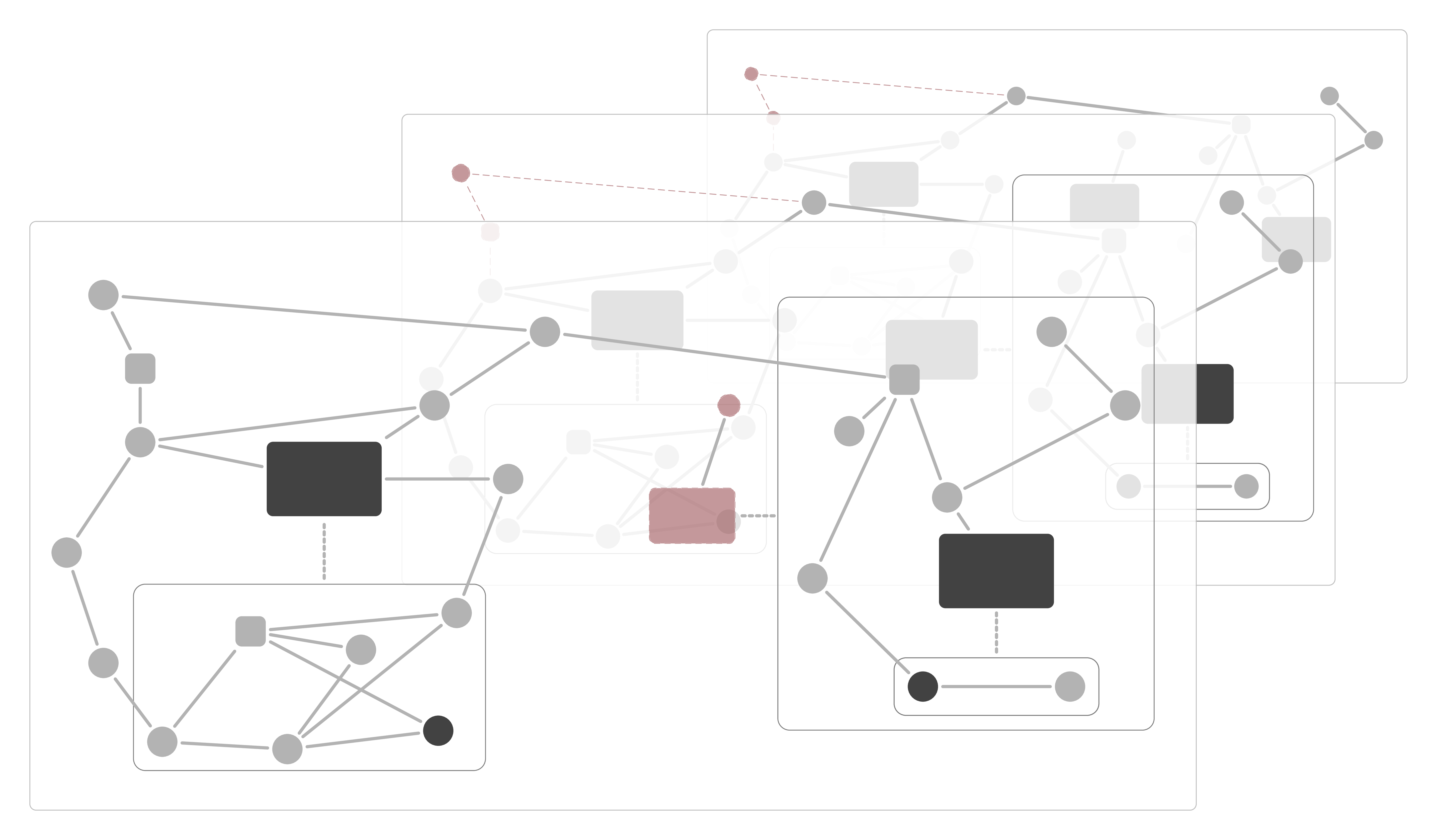
Context
Static program analysis provides us with information regarding the runtime behavior of a program without actually executing it. This is useful for various purposes, ranging from verifying the correctness of a program, over checking it for security issues to fixing issues that prevent the program from compiling or executing.
However, precise static analysis is often very expensive for larger programs making it impractical.
As a simple example, consider a case in which a method invocation may refer to a collection of implementations - based on a non-constant value that is only known at runtime. To be precise, a static analyzer has to consider every possible implementation for each method invocation, including their side-effects and transitive dependencies.
Luckily, a lot of existing research provides a plethora of possible solutions for this problem, proposing
the use of special operators [1], dynamic adjustments of the precision [2], or incremental analysis [3].
Research Problem
The goal of this thesis is to apply existing performance improvements to a static program analyzer for the R programming language and evaluating their effectiveness.
More specifically, the analyzer in question is flowR [4], which is developed here at the University of Ulm with the goal of statically handling R's powerful reflective capabilities and its deeply integrated dynamic nature.
Tasks
In the context of flowR, the main steps of the thesis are:
- Familiarize yourself with flowR's architecture and analysis algorithm
- Adapt and implement a selection of performance improvements to flowR's structure
- Evaluate the performance characteristics of the adapted versions to discuss their impact on the analysis time and precision
Related Work and Further Reading
- Vincenzo Arceri, Greta Dolcetti, and Enea Zaffanella. 2023. Speeding up Static Analysis with the Split Operator. In Proceedings of the 12th ACM SIGPLAN International Workshop on the State Of the Art in Program Analysis (SOAP 2023). Association for Computing Machinery, New York, NY, USA, 14–19.
- D. Beyer, T. A. Henzinger and G. Theoduloz, "Program Analysis with Dynamic Precision Adjustment," 2008 23rd IEEE/ACM International Conference on Automated Software Engineering, L'Aquila, Italy, 2008, pp. 29-38.
- Mudduluru, R., Ramanathan, M.K. (2014). Efficient Incremental Static Analysis Using Path Abstraction. In: Gnesi, S., Rensink, A. (eds) Fundamental Approaches to Software Engineering. FASE 2014. Lecture Notes in Computer Science, vol 8411. Springer, Berlin, Heidelberg.
- github.com/flowr-analysis/flowr
If you want to, you can have a first look at flowR for yourself [4]!
Contact and More
If you are interested and/or have any questions, feel free to contact me any time.
We can discuss the topic further and try to adapt it to your personal preferences.
Florian Sihler (Institute Homepage)

Context
Most static analyzers rely on static dataflow analysis to detect problems like possible null pointer exceptions in code [5].
However, analyzers are usually unable to handle reflective or self-modifying code (e.g., Java Agents, Java Reflection, R's meta-functions [6]). While this is fine for languages in which such constructs are rare or discouraged, they are 1) used quite often in the R programming language, 2) are in-part essential to track program semantics, 3) pose an interesting problem to solve.
Problem
As a basis, we use the static program analysis framework flowR which is designed for the R programming language [3]. flowR is currently unable to deal with reflective and code-modifying constructs like body, quote, and parse in its static dataflow graph.
While handling such constructs statically may be infeasible in the general case, we first want to focus on a set of common cases that appear frequently.
Tasks
- Develop a concept to represent code-modifications and lazy evaluation (within flowR's dataflow graph). For example, to represent a function that has the default values of its arguments or the contents of its body modified.
- Create a proof of concept implementation for this concept in flowR.
Related Work and Further Reading
- K. Cooper and L Torczon. Engineering a Compiler. (ISBN: 978-0-12-818926-9)
- U. Khedker, A. Sanyal, and B. Sathe. Data Flow Analysis: Theory and Practice. (ISBN: 978-0-8493-3251-7)
- F. Sihler. Constructing a Static Program Slicer for R Programs.
- A. Ko and B. Myers. Finding causes of program output with the Java Whyline.
- SonarQube, Sonar.
- Anckaert, B., Madou, M., De Bosschere, K. A Model for Self-Modifying Code.
If you want to, you can have a first look at flowR for yourself: https://github.com/flowr-analysis/flowr.
Contact and More
If you are interested and/or have any questions, feel free to contact me any time.
We can discuss the topic further and try to adapt it to your personal preferences.
Florian Sihler (Institute Homepage)
![[RESERVED] B/M: Automatically Infer Code-Constraints (Sihler, Tichy)](/fileadmin/website_uni_ulm/iui.inst.170/bilder/flowR/code-contracts.png)
Context
Let's suppose you are a data scientist tasked with the analysis of a dataset. As an expert of the domain you have a quick look at the dataset and remember an older script by a colleague which already loads, prepares, and transforms the dataset as you want! Reusing it just leaves you with the task of visualizing the data (as is the common workflow) so you quickly write up and run the script... and luckily realize that even though the script runs and produces figures eerily close to what you would expect, something is not right. The dataset of your colleague never contained a zero so the script contains the implicit assumption of being just able to divide cells.
Within this work we want to make such implicit assumptions explicit in the code, alerting users whenever they no longer hold!
Problem
You have an R script together with the statically inferred dataflow graph that informs you about the control and data dependencies of function calls, variables, and definitions in the program.
The challenges are to
- identify points of interest at which the behavior of the program is defined,
- infer contracts that represent the potential implicit assumptions at the given position (e.g., that the value of a variable has to be non-zero, smaller than the length of another vector, ...), and
- instrument the code to automatically verify these constraints from now on.
Of course, the specific scope of these challenges as well as the focus depends on whether you want to do this as a bachelor's or master's thesis as well as your personal preference.
Tasks
- Enrich flowR [4], a dataflow analysis framework for the R programming language, with the capability to infer predefined constraints
- Create an initial collection of sensible constraints to infer (e.g., non-zero values, ...)
- Infer these constraints and instrument the program to reflect them [5]
One way to infer such constraints would be the definition of abstract domains [1] although classical optimization techniques such as constant folding and constant propagation help as well [2, 3].
Related Work and Further Reading
- P. Cousot. Principles of Abstract Interpretation. (ISBN: 978-0-26-204490-5)
- K. Cooper and L Torczon. Engineering a Compiler. (ISBN: 978-0-12-818926-9)
- U. Khedker, A. Sanyal, and B. Sathe. Data Flow Analysis: Theory and Practice. (ISBN: 978-0-8493-3251-7)
- F. Sihler. Constructing a Static Program Slicer for R Programs.
- B. Meyer, Applying "Design by Contract"
If you want to, you can have a first look at flowR for yourself: https://github.com/flowr-analysis/flowr.
Contact and More
If you are interested and/or have any questions, feel free to contact me any time.
We can discuss the topic further and try to adapt it to your personal preferences.
Florian Sihler (Institute Homepage)
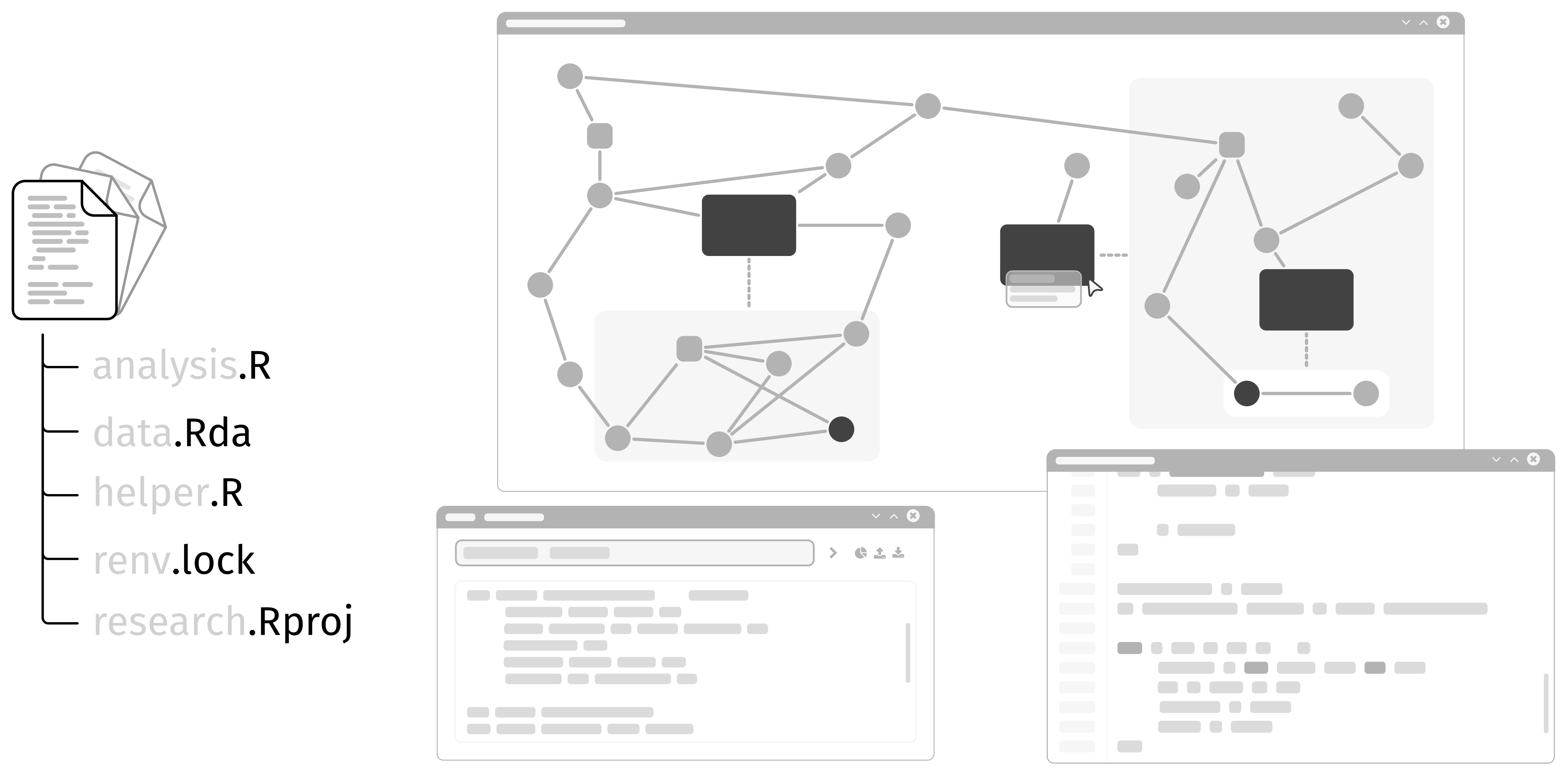
[2–6 Students] [AP SE] [PSE1] [PSE2] [German version below]
Static analysis refers to the examination of programs for runtime properties without actually executing them.
It is an integral part of modern software development and aids in identifying bugs, security vulnerabilities, or improving readability.
Compilers use static analysis to, for example, avoid type errors or generate the most optimal code possible.
Development environments or language servers leverage static analysis to enable features such as refactoring or auto-completion.
In this project, we focus on flowR, a framework for the static analysis of R, a statistical programming language widely used in data analysis and visualization.
A detailed analysis of data and control flow enables flowR to, for instance, reduce a program to only the parts relevant for generating a graphic or computing a statistical model (a technique known as Program Slicing).
About flowR
Currently, flowR can be used and tested as a Visual Studio Code extension, RStudio add-in, or directly as a Docker image.
flowR is developed primarily in TypeScript under the GPLv3 license and is hosted on GitHub.
Documentation is provided through a dedicated Wiki and directly in the code.
Goal
In this project, we aim to extend flowR with support for R projects.
While the analysis of individual and multiple scripts is already supported, this includes in particular:
- Integration with build systems like renv
- Consideration of metadata such as DESCRIPTION or NAMESPACE files
- Support for incremental updates (e.g., when individual files change)
- Resolving package relationships and dependencies
This would enable flowR to be used in larger projects and, for instance, analyze the data flow while accounting for correct package dependencies.
German Version
Statische Programm-Analyse für Projekte
Statische Analyse bezeichnet die Untersuchung von Programmen auf Laufzeiteigenschaften ohne diese tatsächlich auszuführen. Sie ist ein integraler Bestandteil moderner Softwareentwicklung und hilft beim Identifizieren von Fehlern, Sicherheitslücken oder dem Verbessern der Lesbarkeit. Compiler verwenden statische Analyse beispielsweise, um Typfehler zu vermeiden oder möglichst optimalen Code zu generieren. Entwicklungsumgebungen oder Language Server verwenden statische Analyse, um Ihre Funktionalität wie Refactorings oder Autovervollständigung zu realisieren.
In diesem Projekt widmen wir uns flowR, einem Framework für die statische Analyse von R, einer statistischen Programmiersprache die häufig in der Datenanalyse und -visualisierung eingesetzt wird. Eine ausgiebige Analyse des Daten- und Kontrollflusses ermöglicht es flowR beispielsweise ein Programm nur auf die Teile zu reduzieren, die für die Generierung einer Grafik oder die Berechnung eines statistischen Modells relevant sind (das sogenannte Program Slicing).
Über flowR
Aktuell kann flowR als Erweiterung für Visual Studio Code und RStudio, sowie direkt als Docker Image verwendet und ausprobiert werden.
flowR wird unter der GPLv3 Lizenz auf Github hauptsächlich in der Programmiersprache TypeScript entwickelt. Die Dokumentation erfolgt über ein dediziertes Wiki und direkt im Code.
Ziel
Im Anwendungsprojekt wollen wir flowR um eine Unterstützung für R Projekte zu erweitern.
Während die Analyse von einzelnen und auch mehreren Skripten bereits unterstützt wird, zählt hierzu insbesondere die:
- Integration von Build-Systemen wie renv
- Berücksichtigung von Metadaten wie DESCRIPTION oder NAMESPACE Dateien
- Unterstützung von inkrementellen Aktualisierungen (z.B. wenn sich einzelne Dateien ändern)
- Auflösung von Paketbeziehungen und Abhängigkeiten
Auf diese Weise kann flowR auch in größeren Projekten eingesetzt werden und beispielsweise den Datenfluss unter der Berücksichtigung der richtigen Paketabhängigkeiten analysieren.
Self-adaptive Systems
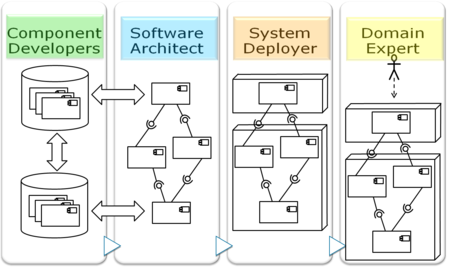
Context
Self-Adaptive systems are systems that adjust themselves to maintain or improve their performance in response to changes in their environment and operational conditions, thereby ensuring continued effectiveness, reliability, and efficiency.
Self-adaptive systems are diverse and multifaceted, with applications extending across numerous fields. In our project, we concentrate on the cloud-native domain, with a special emphasis on the explainability aspect of self-adaptation. This involves delving into how these systems can not only adjust autonomously to changing conditions but also provide transparent and understandable explanations for their adaptations, ensuring clarity and trust in their operations.
In the MENTOR project, we use Palladio Component Models (PCM) of Self-Adaptive Microservices to simulate the system. These simulations are used to analyze and improve the performance of the systems reconfiguration behavior. To test the performance of our appraoch, we need PCM models of different systems to ensure generalizability and detect potential issues with our approach.
Problem
In this Master thesis, a prototype implementation of a PCM model generator has to be created. This prototype should get a set of constraints (e.g., Nmin≤∣C∣≤Nmax; ∀s∈S:λmin≤ArrivalRate(s)≤λmax; ∀(ci,cj)∈PotentialConnections:Lmin≤Latency(ci,cj)≤Lmax; ∀c∈Cpattern∖{ccenter},c→ccenter) and generate one or multiple pcm models satisfying the constraints. The generated models then have to be verified to ensure that they are well formed.
To generate the models, we imagine a combination of a constraint solver and a LLM. However, we are also open to other appraoches, for example using Answer Set Programming.
Tasks/Goals
- Familiarization with the PCM meta model
- Familiarization with constraint solver, LLMs, etc.
- Implement a Prototype
- Evaluate the Implementation
- Implement a Prototype
- Evaluate the Implementation
Context
Self-Adaptive systems are systems that adjust themselves to maintain or improve their performance in response to changes in their environment and operational conditions, thereby ensuring continued effectiveness, reliability, and efficiency.
Self-adaptive systems are diverse and multifaceted, with applications extending across numerous fields. In our project, we concentrate on the cloud-native domain, with a special emphasis on the explainability aspect of self-adaptation. This involves delving into how these systems can not only adjust autonomously to changing conditions but also provide transparent and understandable explanations for their adaptations, ensuring clarity and trust in their operations.
In the MENTOR project, we use Palladio Component Models (PCM) of Self-Adaptive Microservices to simulate the system. These simulations are used to analyze and improve the performance of the systems reconfiguration behavior. To test the performance of our appraoch, we need PCM models of different systems to ensure generalizability and detect potential issues with our approach.
Problem
Our state graphs get too large to display. We need to visualize all states in a comprehensive and understandable way. Ensure the visualization is intuitive and easy to understand
Tasks/Goals
- Develop visualization concepts for Large State Graphs
- Implement the delevoped visualization concepts
- Develop the solution in React/Typescript
Configurable Software Systems
Identification of Feature Interactions in Configurable Software
Context
In software product lines, variability is determined by features that can be included or excluded to create a specific configuration. T-wise sampling algorithms aim to generate samples that cover every possible combination of t features in at least one configuration within the sample set.
Problem
Some products/configurations may contain bugs resulting from errors that arise when multiple features are combined. These faulty feature interactions can potentially mask other errors. Currently, error masking/shadowing in configurable software is understudied that is why we want to investigate this topic.
Tasks
- Research on occurencies of complex feature interaction bugs and error masking bugs in configurable software systems
- Detect, compare, and discuss the complex feature interactions
Contact
Context
In the paper "A classification of product sampling for software product lines" (SPLC'18)", Mahsa et al. propose a classification for product sampling techniques by classifying the existing literature.
Problem
Since 2018, more recent publications have emerged addressing product line sampling, alongside new research topics of growing interest.
Tasks
- Literature research
- Investigate and classify new research topics and research gaps of growing interest
Contact
Constraint-Programmierung und Constraint Handling Rules
FreeCHR
The declarative programming language Constraint Handling Rules (CHR) is designed as a language extension to other, not necessarily declarative programming languages. There are existing implementations for Prolog, C, Java, JavaScript, and others. We want to conduct a Structured Literature Research (SLR) on existing implementations, to get an exhaustive overview over implementation techniques and patterns.
Goals
- Conduct an SLR on papers on existing CHR implementations
- Find CHR implementations without a scientific publication on public repositories on, e.g. GitHub, GitLab, ...
- Identify and document common architectures, implementation techniques and patterns
- Get an exhaustive overview over existing and historic CHR implementations
References
- T. Frühwirth: Constraint Handling Rules - What Else?
- S. Sneyers et al.: As time goes by: Constraint Handling Rules
- P. Van Weert: Efficient Lazy Evaluation of Rule-Based Programs
- P. Van Weert, P. Wuille, T. Schrijvers, B. Demoen: CHR for Imperative Host Languages
- F. Nogatz, T. Frühwirth, D. Seipel: CHR.js: A CHR Implementation in JavaScript
- Dragan Ivanović: Implementing Constraint Handling Rules as a Domain-Specific Language Embedded in Java
Prerequesites
- Interest in programming languages and (to some extend) compiler construction.
- Good knowledge of multiple programming languages and paradigms.
Contact
FreeCHR aims to be a sound and complete embedding framework for CHR. Hence, we want to extend the operational semantics by possibly failing computation, as they are necessary for the development of constraint solvers and other software.
Goals
- Extend the very abstract operational semantics of FreeCHR, such that they can model possibly failing computations
- Prove soundness and completeness w.r.t. the very abstract operational semantics of CHR
- Optional: Develop an execution algorithm and prove correctness w.r.t. the new operational semantics
References
- S. Rechenberger, T. Frühwirth: FreeCHR - An Algebraic Framework for CHR Embeddings
- T. Frühwirth: Constraint Handling Rules (ISBN: 978-0-521-87776-3)
Prerequesites
- Interest in formal aspects of programming languages
- Interest/knowledge in category theory and/or type systems is recommended
- Knowledge in functional programming, especially monads
Contact
FreeCHR aims to be a sound and complete embedding framework for CHR. Hence, we want to extend the operational semantics by stateful computation, as they are common in many programming languages.
Goals
- Extend the very abstract operational semantics of FreeCHR, such that they can model stateful computations
- Prove soundness and completeness w.r.t. the very abstract operational semantics of CHR
- Optional: Develop an execution algorithm and prove correctness w.r.t. the new operational semantics
References
- S. Rechenberger, T. Frühwirth: FreeCHR - An Algebraic Framework for CHR Embeddings
- T. Frühwirth: Constraint Handling Rules (ISBN: 978-0-521-87776-3)
Prerequesites
- Interest in formal aspects of programming languages
- Interest/knowledge in category theory and/or type systems is recommended
- Knowledge in functional programming, especially monads
Contact
FreeCHR aims to be a sound and complete embedding framework for CHR. The abstract operational semantics are a next step in the direction of modelling the necessities of real-life programming languages. Hence, we want to re-formalize them in the context of FreeCHR and establish soundness and completeness.
Goals
- Formalize the abstract operational semantics ωt of CHR in the terms of (side-effect free) FreeCHR
- Prove soundness and completeness of the new definition
References
- S. Rechenberger, T. Frühwirth: FreeCHR - An Algebraic Framework for CHR Embeddings
- T. Frühwirth: Constraint Handling Rules (ISBN: 978-0-521-87776-3)
Prerequesites
- Interest in formal aspects of programming languages
- Interest/knowledge in category theory and/or type systems is recommended
Contact
Constraint Handling Rules
We are developing a rule-based implementation of a tool to analyse and generate graphs. It is used in the domain of mason’s marks. For thousands of years, stonemasons have been inscribing these symbolic signs on dressed stone. Geometrically, mason’s marks are line drawings. They consist of a pattern of straight lines, sometimes circles and arcs. We represent mason’s marks by connected planar graphs. Our prototype tool for analysis and generation of graphs is written in the rule-based declarative language Constraint Handling Rules. One or several of following features could be improved in this proposed work:
Goals/Tasks
- improve the vertex-centric logical graph representation, i.e. adding arcs, colors, labels,
- encode existing mason marks either by hand, from images or import from existing databases,
- recognize (sub)graphs and patterns in a graph, in particular (self-)similarities and correlations between graphs,
- perform classical algorithms on graphs like shortest paths,
- derive properties and statistics from graphs,
- generate (randomly or exhaustively) and draw graphs from given constrained subgraphs based on properties and statistics.
References
Prerequesites
- Good knowledge of Prolog and CHR
- Lecture Rule-based Programming
Contact
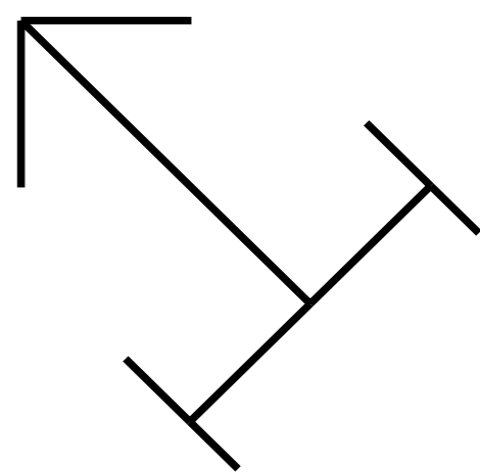
Extend the analysis techniques and/or the associated tool from the following two research papers:
A dynamic program analysis of the non-termination problem for recursion in the Constraint Handling Rules (CHR) language: A simple program transformation for recursive rules in CHR was introduced that produces one or more adversary rules. When the rules are executed together, a non-terminating computation may arise. It was shown that any non-terminating computation of the original rule contains this witness computation.
References
- Thom Fruehwirth: A Devil's Advocate against Termination of Direct Recursion, PPDP 2015.
- Transformation Tool available (use "Devil" options).
A static program analysis of the non-termination problem for recursion in the Constraint Handling Rules (CHR) language: Theorems with so-called misbehavior conditions for potential non-termination and failure (as well as definite termination) of linear direct recursive simplification rules are given. Logical relationships between the constraints in a recursive rule play a crucial role in this kind of program analysis.
References
Prerequesites
- Lecture "Rule-Based Programming"
Contact

Invariants (or assertions, properties, conditions) annotate program text and express static and dynamic properties of a program's execution. Invariants can be expressed as logical relations (predicates) over the program's variables. In the context of constraint-programming and Constraint Handling Rules (CHR), they amount to constraints. These can be readily added to the program to enforce the invariants. By comparing the program with and without invariants expressed as constraints using established program analysis techniques for CHR, namely confluence and program equivalence, we can check if the invariants hold in the program.
Furthermore, invariants can be strenghened and even be generated by adapting the so-called completion method (that is normally used to generate additional rules to make a CHR program confluent).
References
Prerequisites
Contact
Program slicing is a program anaylsis technique whereby one extracts properties and relationships of variables in a program by removing from the program all statements that do not effect the assignments of the variables. In the context of constraint programming and Constraint Handling Rules that deal with logical relations (predicates) this amounts to the logical operation of variable projection. This means that we remove unwanted variables that are not of interest from the program by program transformation. This transformation can be accomplished by adapting the technique of "completion". It is usually used to make a non-confluent program confluent.
References
Prerequisites
- Lecture "Rule-based Programming
Contact

Repeated recursion unfolding is a new approach that repeatedly unfolds a recursion with itself and simplifies it while keeping all unfolded rules. Each unfolding doubles the number of recursive steps covered. This reduces the number of recursive rule applications to its logarithm at the expense of introducing a logarithmic number of unfolded rules to the program. Efficiency crucially depends on the amount of simplification inside the unfolded rules. A super-linear speedup is provably possible in the best case, i.e. speedup by more than a constant factor. The optimization can lower the time complexity class of a program.
Goals
The goal is to implement this optimization scheme as a program transformation in the programming language of choice. If necessary, the scheme should be transferred from recursion to iteration constructs such as loops.
References
Prerequisite
- Excellent knowledge and programming skills in the choosen programming language.
Contact
Prolog (WAM) and then Java (JVM) popularized the concept of an abstract (or virtual) machine to implement programming languages in a systematic, portable yet efficient way. Such a machine shall be developed for CHR.
Goals
Define the abstract code instructions for CHR and to implement them.
Prerequesites
- Good knowledge of Prolog and CHR
- Lecture Rule-based Programming
- Lecture Compiler Construction (Compilerbau) (optional but very helpful)
Contact
Quality-driven System Evolution
Architecture-based Modelling and Analysis of Security
Motivation
Moderne Softwaresysteme sind zunehmend komplex und vernetzt, was eine umfassende Analyse zur Sicherstellung von Qualit ¨atsmerkmalen wie Vertraulichkeit unerlässlich macht. Eine architekturbasierte Vertraulichkeitsanalyse ermöglicht die frühzeitige Erkennung potenzieller Verstöße gegen die Vertraulichkeit und trägt somit zur effektiven Vermeidung von Datenlecks bei. Allerdings erschweren Unsicherheiten im System selbst sowie in seiner Umgebung eine präzise und vollständige Analyse der Softwarearchitektur. Die hohe Komplexität architektonischer Modelle und die Vielzahl möglicher Unsicherheiten führen darüber hinaus zu einer kombinatorischen Explosion, die eine automatisierte Modellreparatur erheblich erschwert. In der Praxis müssen Softwarearchitekt:innen daher alle Verstöße manuell beheben – ein aufwändiger und fehleranfälliger Prozess. Zwar existieren bereits Ansätze zur Identifikation von Vertraulichkeitsverletzungen unter Unsicherheit, jedoch fehlt es bislang an wirksamen Methoden zur Minderung ihrer Auswirkungen.
Aufgabenstellung
Im Rahmen dieser Arbeit entwickeln Sie einen innovativen Ansatz zur automatisierten Behebung von Vertraulichkeitsverletzungen in Datenflussdiagrammen unter Nutzung von Sprachmodellen wie GPT. Dazu wird das Modell in einem strukturierten Format (z.B. JSON) an das
Sprachmodell übergeben. Das Sprachmodell soll daraufhin einen Lösungsvorschlag generieren. Die Qualität der vorgeschlagenen Lösung wird anschließend mithilfe eines von uns bereitgestellten Analyseverfahrens überprüft. Basierend auf dieser Bewertung wird ein iterativer Feedback-Loop mit dem Sprachmodell aufgebaut, um die Ergebnisse sukzessive zu verbessern.
Kontakt
Bei Interesse und/oder Fragen können Sie mich jederzeit kontaktieren. Wir können das Thema gerne weiter besprechen und versuchen, es an Ihre persönlichen Wünsche anzupassen.
Robert Heinrich (Institute Homepage)
Motivation
Moderne Softwaresysteme sind zunehmend komplex und vernetzt, was eine umfassende Analyse zur Sicherstellung von Qualitätsmerkmalen wie Vertraulichkeit unerlässlich macht. Eine architekturbasierte Vertraulichkeitsanalyse ermöglicht die frühzeitige Erkennung potenzieller Verstöße gegen die Vertraulichkeit und trägt somit zur effektiven Vermeidung von Datenlecks bei. Allerdings erschweren Unsicherheiten im System selbst sowie in seiner Umgebung eine präzise und vollständige Analyse der Softwarearchitektur. Die hohe Komplexität architektonischer Modelle und die Vielzahl möglicher Unsicherheiten führen darüber hinaus zu einer kombinatorischen Explosion, die eine automatisierte Modellreparatur erheblich erschwert. In der Praxis müssen Softwarearchitekt:innen daher alle Verstöße manuell beheben – ein aufwändiger und fehleranfälliger Prozess. Zwar existieren bereits Ansätze zur Identifikation von Vertraulichkeitsverletzungen unter Unsicherheit, jedoch fehlt es bislang an wirksamen Methoden zur Minderung ihrer Auswirkungen.
Aufgabenstellung
Ziel dieser Arbeit ist die Entwicklung eines Verfahrens zur automatisierten Behebung von Vertraulichkeitsverletzungen in Softwarearchitekturen mithilfe diskreter Optimierungstechniken. Dabei sollen gezielte Modelländerungen vorgenommen werden, um alle identifizierten Verstöße zu beseitigen – und gleichzeitig die Änderungskosten so gering wie möglich zu halten. Hierfür ist zunächst eine geeignete Kostenfunktion für Modelländerungen zu definieren. Anschließend soll ein Optimierungsansatz (z.B. basierend auf Integer Linear Programming oder Constraint Solving) entwickelt und implementiert werden, der eine optimale Reparaturlösung ermittelt. Die Qualität der Lösung wird mithilfe einer bestehenden Analyse validiert und kann mit anderen Reparaturansätzen verglichen werden.
Kontakt
Bei Interesse und/oder Fragen können Sie mich jederzeit kontaktieren. Wir können das Thema gerne weiter besprechen und versuchen, es an Ihre persönlichen Wünsche anzupassen.
Motivation
Choosing inappropriate configurations of blockchain systems for decentralized applications (DApps) can entail serious issues, including exposure to attacks, too slow performance, and high costs. Such inappropriate blockchain system configurations can even require migrating to a new system, which is extremely difficult once a blockchain system is deployed. Every node would need to set up a completely new blockchain system, and crucial data could get lost. To configure blockchain systems that meet DApp requirements on dependability, decentralization, and performance, software architects need tooling to simulate and analyze the influence of blockchain system configurations on the behaviors and quality of blockchain systems before deployment. In particular, novel modeling, simulation, and prediction approaches are needed to estimate and explain the behavior of blockchain systems to ensure they meet DApp requirements on dependability before setup.
Topic Overview
Within the context of developing suitable blockchain systems for DApps, several topics for Bachelor/Master thesis are available as listed in the following. In addition to these topics, we will be happy to discuss your own ideas for thesis topics on blockchain technology.
- DApp Archetypes: Develop archetypal DApps that can be used to bootstrap productive DApps.
- Mitigation of Security Risks by Design: Develop new security analyses for blockchain systems to help improve their robustness against common attacks (e.g., selfish mining attacks) by design.
- Modeling and Simulation: Design a modeling language to represent blockchain systems or DApps using the Palladio modelling and analysis approach. Implement an extension for the Palladio analysis tool to assess blockchain systems for security vulnerabilities or performance bottlenecks. Evaluate your extension of the Palladio tool.
- Trade-offs in Blockchain Systems: Develop new analysis techniques to assess the quality attributes and behaviors of blockchain systems with a focus on the blockchain trilemma.
Contact and More
If you are interested and/or have any questions, feel free to contact me any time. We can discuss the topic further and try to adapt it to your personal preferences.
Context
Attack analysis is typically conducted by cybersecurity experts, who possess in-depth knowledge in this field. However, cybersecurity experts often do their job in the development phase, or even after the software system is released. When designing the software architectures or cyber-physical systems (CPSs), architects often miss the security aspects due to their knowledge.
Problem
The attacks can propagate through the system due to a misconfiguration or an unawareness of the implicit access control policies. Selecting an appropriate mitigation technique requires a lot of expert knowledge.
Tasks/Goals
- Research and develop an approach to use architectural analysis and a large language model (LLM) to mitigate an attack.
- Using architecture, we use Palladio Component Model (PCM) as the architectural description language, and ask LLM to identify the vulnerabilities and provide a suggestion to mitigate the vulnerabilities.
- Analyse the attack propagation with the proposed mitigation.
Contact and More
If you are interested and/or have any questions, feel free to contact us any time. We can discuss the topic further and try to adapt it to your personal preferences.
Context
We developed an Eclipse-based attack propagation analysis tool. This tool helps architects to analyse how an attack propagates through their architecture at design time by modelling vulnerabilities and conducting the attack analysis.
Problem
Our tool is developed based on Eclipse Modeling Tools, therefore it needs to be installed on the architect's machine. Sometimes, they need to install third-party libraries before using our tool. In addition, our tool also needs graphical features to make the modelling task easier.
Tasks
- Develop an online modelling tool to allow modelling an attacker by using a website.
- Develop the function for the online tool to allow conducting an attack propagation analysis.
- Develop the extract function of the online tool to deliver an attractive attack graph.
Results
- A website that allows users to conduct an attack propagation analysis.
- The online tool can be shipped as a dockerized package.
Contact and More
If you are interested and/or have any questions, feel free to contact us any time. We can discuss the topic further and try to adapt it to your personal preferences.
